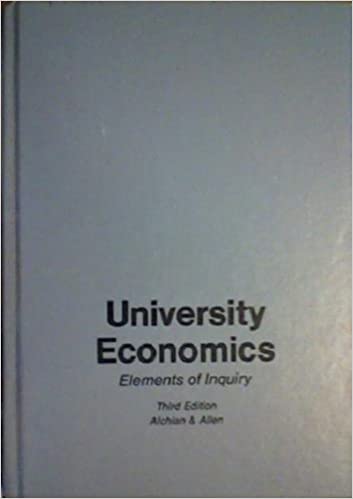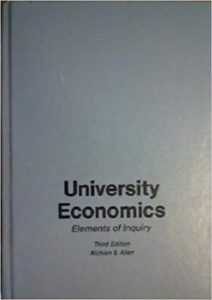

One of the best parts of Alchian and Allen’s classic textbook, University Economics, is its discussion of the cost-price illusion. The analysis, though worded somewhat differently, is also in the newer textbook Universal Economics, which is based on the original. It’s free online from Liberty Fund.
Here’s the passage:
SPEED OF DETECTING CHANGES IN DEMAND OR SUPPLY: THE ILLUSION THAT COST DETERMINES PRICE
Buffer stocks, inventories, and reserve capacity help make it appear as if prices are sluggish or inflexible and are determined by costs, instead of by competition among consumer-demanders. Suppose that for some reason (possibly higher incomes) demand for meat increases. As sales and consumption increase, butchers’ inventories are unexpectedly depleted. Normally, as with any retailer, inventories are large enough to accommodate transiently increased sales without producers having to raise prices. Inventories larger than an average day’s sales help assure that supplies are immediately available to demanders at predictable prices.
One day’s above-average sales is not regarded instantly as a persistent increase at that price; nor is it viewed as a long-term sales increase that requires a higher price to keep inventories from being further depleted. When the increase in sales reflects a higher average demand, no seller will be able to detect the increase in demand immediately. A high transient deviation may induce retailers to purchase more for replacement of normal inventories, but they would buy even more if they knew the long-term demand had increased.
If the public’s aggregate demand really had increased (not just toward this one butcher and away from other butchers), the demand by all butchers to restore inventories would increase the demand facing the meat packer-suppliers. Packers will see their inventories declining as they supply more meat to retailers.
To replenish their extraordinarily depleted inventories, packers will compete with each other for more cattle than before. But with an unchanged supply of cattle, some packers must get less than the increased amount they demand at the old price. They bid up the price of cattle. The packers are, in this scenario, the first to see a price (cattle cost) rise consequent to the increased consumer demand, and they will correctly interpret that as a rise in their costs.
The existence of inventories in the chain of suppliers from producer to consumer can cause a delay during which the increased consumer demand is communicated Edition: current; Page: [149] from retailers to initial producers. That delays the price increase until the cattle-producer stage.
WHO IS RESPONSIBLE FOR HIGHER PRICES? LOOK IN THE MIRROR
Packers raise their prices to retailers, saying their prices are higher because their costs are higher. But we know that costs are higher because it was the increased consumer demand that prompted a higher price of cattle at the feedlot. Because of the increased consumer demand, a higher price is obtained and maintained in the consumer market. When consumers complain about the higher price of meat, butchers say it isn’t their fault. Their costs have gone up. And the packers can say the same. To see who really was responsible for the higher prices, the consumers can look in the mirror behind the butcher’s counter and see themselves.
Not all prices adjust instantly to the new equilibrium price to clear the market, as they do in the organized stock and commodity markets. In fact, a lag occurs between the time some demand or supply situation has changed and the time people detect and distinguish that from a random, transient, reversible change in the current purchase rates or in supply conditions.
As emphasized earlier, the amount demanded may refer to the underlying average amount demanded in an interval, with momentary random offsetting deviations taking place around that average value. Because of the transient variations around the average, a shift in that average may be hard to detect quickly. An increase in sales may be interpreted as only a randomly high sales rate, rather than as a new higher normal sales rate. And once a seller begins to suspect that demand has shifted, difficulties exist in knowing what are the best adjustments to make in supply response.
If the demand is believed to have fallen, should a supplier shift to some other production activity or should the price be lowered and work continued at a lower rate? Should an employer attempt to reduce wages of employees immediately when sales fall?
So-called delays and lags in adjusting price or output are the result of inability to foresee the future perfectly and to understand what really is happening. They are not results of some inherent inflexibility in, or inability to change, prices. It takes time to decide that an underlying change, rather than a random, transient deviation has occurred. And the time it takes to discover what is the most appropriate adjustment misleads outside observers into thinking that prices are “rigid.” Prices actually are instantly flexible—as instantly as it is discovered that a change is appropriate.
Edition: current; Page: [150]
Why is this particularly relevant today? Because many commentators argue that cost increases are the cause of price increases. That can be true. But more often, given the huge recent increases in the money supply, it’s demand increases that are driving price increases. But the way that often shows up is similar to the analysis in Alchian and Allen.

READER COMMENTS
Andrew_FL
Aug 30 2022 at 9:39am
Alchian and Allen refreshingly analyze the market process of price adjustment, rather than relying on hydraulic theories where prices automatically respond, or don’t, to changes in nominal demand.
Todd Ramsey
Aug 30 2022 at 11:27am
Genius. So clear and concise, it can be remembered forever having been read just once.
Henri Hein
Aug 30 2022 at 3:14pm
I didn’t know the term “cost-price illusion,” but it captures the issue neatly. It’s another fallacy ubiquitous in the public discourse.
Bill Conerly
Aug 30 2022 at 5:10pm
Excellent.
I’ve heard free market economists attribute all or most shortages to government regulation. But my consulting clients are like Alchian and Allen’s hypothetical businesses: they never see supply and demand curves, just some data points. They don’t really know their marginal cost curve, and they may not have a good idea of any points on that curve. Sometimes they are surprised by external events, not sure how to respond, and consequently cannot supply all that their clients want to buy. But to preserve relationships, they may not raise prices, but instead let lead times grow or decline to serve new customers.
Free market advocates should understand the market is not perfect (though better than the alternatives).
Herb
Aug 31 2022 at 9:58pm
The statement: “To see who really was responsible for the higher prices, the consumers can look in the mirror…”, is true, but in most cases, the consumer is “pushed”. Take today – the Executive branch & Congress spew money, the Fed prints, the consumer feels flush (or panicky, depending on the rate of increase), & this leads to increased demand.
Although it has been a few years since I read the latest version, I found their book to be a great discussion of economics. I highly recommend it.
Matthias
Sep 2 2022 at 1:30am
I generally agree with the article.
However, lags are not inevitable. Market participants don’t necessarily have to rely just on lagging price signals. They are free to speculate about how future prices might evolve and act accordingly.
Of course, speculation can go wrong. Just like telling apart random fluctuations from a change in the trend can go wrong.
As an example of anticipation:
If the government (or some charity etc) publicly announces today that starting in exactly one year there will be a subsidy of 1 dollar for each cheeseburger sold to retail customers, then you will see the changes all over the supply change without having to wait for gradual transmission of information via actual sales in late 2023.
Similarly futures markets can help spread information about coming conditions faster, without requiring a wait for any actual transactions in the spot market under the new conditions.
Comments are closed.